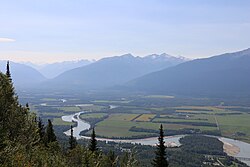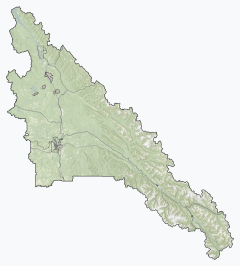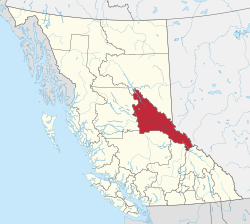Regional District of Fraser–Fort George Regional district in British Columbia, Canada
Regional district in British Columbia, Canada
Fraser–Fort George
Regional District of Fraser–Fort George
Flag
Logo
Major communities
Location in British Columbia
Country Canada Province British Columbia Administrative office location Prince George • Type Regional district • Body Board of directors • Chair Art Kaehn (E) • Vice chair Lara Beckett (C) • Electoral areas
A – Salmon River–Lakes
C – Chilako River–Nechako
D – Tabor Lake–Stone Creek
E – Woodpecker–Hixon
F – Willow River–Upper Fraser
G – Crooked River–Parsnip
H – Robson Valley–Canoe • Land 50,676.10 km2 (19,566.15 sq mi) • Total
94,506 • Density 1.86/km2 (4.8/sq mi) Website www
The Regional District of Fraser–Fort George (RDFFG ) is a regional district located in the Central Interior of British Columbia , Canada. It is bounded by the Alberta border to the east, the Columbia–Shuswap and Thompson–Nicola regional districts to the south and southeast, Cariboo Regional District to the southwest, the Regional District of Bulkley–Nechako to the west, and the Peace River Regional District to the north and northeast. As of the Canada 2011 Census , Fraser–Fort George had a population of 91,879 and a land area of 51,083.73 km2 (19,723.54 sq mi). The offices of the regional district are located at Prince George .
Communities
City
District municipality
Villages
Regional district electoral areas
Fraser–Fort George A – Salmon River–Lakes
Fraser–Fort George C – Chilako River–Nechako
Fraser–Fort George D – Tabor Lake–Stone Creek
Fraser–Fort George E – Woodpecker–Hixon
Fraser–Fort George F – Willow River–Upper Fraser
Fraser–Fort George G – Crooked River–Parsnip
Fraser–Fort George H – Robson Valley–Canoe
Indian Reserves
NB Indian Reserves are not part of municipal or regional district governance and are outside the regional district's jurisdiction, and also counted separately in the census figures.
Designated places
Demographics
As a census division in the 2021 Census of Population conducted by Statistics Canada , the Regional District of Fraser-Fort George had a population of 2 (19,529.33 sq mi), it had a population density of 2 (5.0/sq mi) in 2021.[ 3]
Panethnic groups in the Fraser–Fort George Regional District (1991–2021)
Panethnic 2021[ 4]
2016[ 5]
2011[ 6]
2006[ 7]
2001[ 8]
1996[ 9]
1991[ 10] [ 11]
Pop. %
Pop.
%
Pop.
%
Pop.
%
Pop.
%
Pop.
%
Pop.
%
European [ a] 71,800
72,560
73,895
77,320
80,945
87,785
78,765
Indigenous
13,995
13,395
10,915
9,630
8,875
6,355
7,970
South Asian
4,060
2,640
2,020
2,040
2,620
2,035
1,930
Southeast Asian [ b] 1,850
1,460
1,250
780
615
355
365
East Asian [ c] 1,565
1,390
1,345
1,130
1,095
1,290
810
African
1,170
755
615
400
380
360
380
Latin American
265
275
155
140
205
95
130
Middle Eastern [ d] 250
215
205
65
0
50
30
Other[ e]
335
240
105
130
130
170
—
—
Total responses
95,300
92,935
90,495
91,625
94,855
98,505
90,380
Total population
96,979
94,506
91,879
92,264
95,317
98,974
90,739
Note: Totals greater than 100% due to multiple origin responses.
Notes
^ Statistic includes all persons that did not make up part of a visible minority or an indigenous identity.
^ Statistic includes total responses of "Filipino" and "Southeast Asian" under visible minority section on census.
^ Statistic includes total responses of "Chinese", "Korean", and "Japanese" under visible minority section on census.
^ Statistic includes total responses of "West Asian" and "Arab" under visible minority section on census.
^ Statistic includes total responses of "Visible minority, n.i.e. " and "Multiple visible minorities" under visible minority section on census.
References
^ "Board of Directors" . Retrieved July 9, 2019 .^ a b "Population and dwelling counts, for Canada, provinces and territories, and census divisions, 2016 and 2011 censuses – 100% data (British Columbia)" . Statistics Canada . February 8, 2017. Retrieved July 9, 2019 .^ "Population and dwelling counts: Canada and census divisions" . Statistics Canada . February 9, 2022. Retrieved April 3, 2022 .^ Government of Canada, Statistics Canada (October 26, 2022). "Census Profile, 2021 Census of Population" . www12.statcan.gc.ca . Retrieved February 17, 2023 . ^ Government of Canada, Statistics Canada (October 27, 2021). "Census Profile, 2016 Census" . www12.statcan.gc.ca . Retrieved February 17, 2023 . ^ Government of Canada, Statistics Canada (November 27, 2015). "NHS Profile" . www12.statcan.gc.ca . Retrieved February 17, 2023 . ^ Government of Canada, Statistics Canada (August 20, 2019). "2006 Community Profiles" . www12.statcan.gc.ca . Retrieved February 17, 2023 . ^ Government of Canada, Statistics Canada (July 2, 2019). "2001 Community Profiles" . www12.statcan.gc.ca . Retrieved February 17, 2023 . ^ Government of Canada, Statistics Canada (June 4, 2019). "Electronic Area Profiles Profile of Census Divisions and Subdivisions, 1996 Census" . www12.statcan.gc.ca . Retrieved February 17, 2023 . ^ Government of Canada, Statistics Canada (March 29, 2019). "1991 Census Area Profiles Profile of Census Divisions and Subdivisions – Part B" . www12.statcan.gc.ca . Retrieved February 18, 2023 . ^ Government of Canada, Statistics Canada (March 29, 2019). "Data tables, 1991 Census Population by Ethnic Origin (24), Showing Single and Multiple Origins (2) – Canada, provinces and territories, census divisions and census subdivisions" . www12.statcan.gc.ca . Retrieved February 18, 2023 .
External links
Places adjacent to Regional District of Fraser–Fort George



